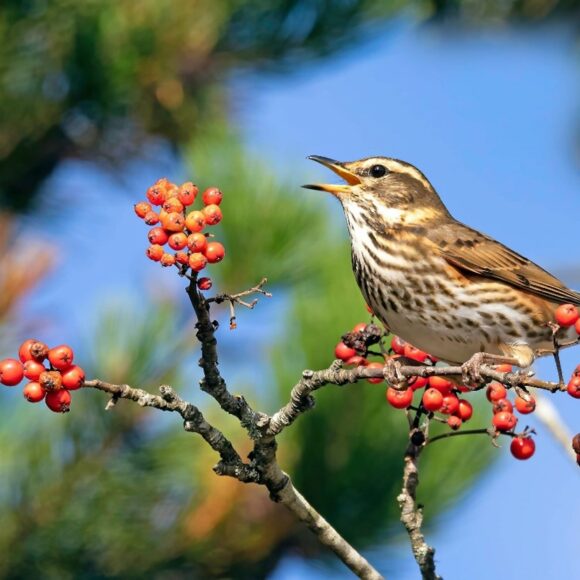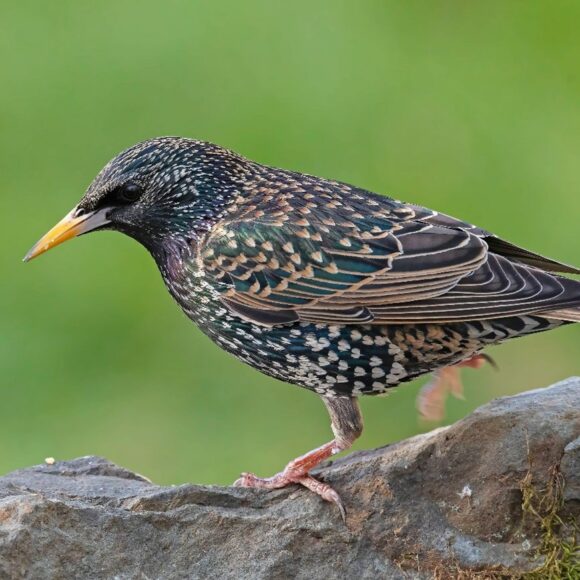
Look Wild: Bird watching in the Peaks
-
Date posted: 01/02/2024
-
Time to read: 8 minutes
Winter can often be thought of as the time when wildlife goes to sleep, but many animals have to migrate to take advantage of seasonal resources to survive. Some migrations are relatively short, especially for mammals, but many birds take advantage of the power of flight to make truly epic journeys, crossing continents and oceans. Its estimated that up to 40% of the world’s birds are considered to be regular migrants.
Its not even as simple as birds simply coming south for winter or to breed, there are actually many different types of migration that birds use to utilise the maximum availability of food, daylight, warmer temperatures and more stable weather conditions. Lets take a look at some of the different types of migration and the birds that undertake these amazing journeys to join us in the Peak District for winter.
Seasonal migration
This is the most common form of bird movement globally. Usually this is the movement between breeding and non-breeding ranges. The birds that arrive on our shores in winter do not usually breed in the UK and are native to places like Scandinavia and Iceland. Birds include redwing, fieldfare, barnacle goose, pink footed goose and the sanderling.

Redwing (Turdus iliacus)
- Looks like a song thrush, but identifiable by the red patch under their ‘armpit’
- There can be up to 700,000 redwings in the UK over winter
- Feeds on berries and worms
Longitudinal migration
Particularly common in continental Europe due to the diverse geographical features, this is the movement of birds between eastern and western regions. Usually numbers of birds native in the UK increase dramatically during the winter months when birds arrive from northern Europe. During winter, birds arrive from the North where the weather is unmanageable. Insect eating birds in particular need to migrate to warmer as their food is not available. Birds include starling, robin, blackbird, lapwing and even goldcrest.

Starling (Sturnus vulgaris)
- Slightly smaller than blackbirds Can look dark in colour, but feather are iridescent blue, green and purple, spotted with white and silver
- Feeds on invertebrates and fruit
- Known for their spectacular murmuration’s, which can sometimes total anything from 100 to over a million birds
Irruptions
Irregular migrations are caused by a lack of food and water, resulting in large numbers of birds flying to unfamiliar areas. On an influx year, they can be spotted even in towns and car parks. We have had 100’s of waxwings for over a month on the Monsal Trail near Bakewell this year, which is a perfect place to welcome visitors with all accessibility needs. The large influx of Waxwings to the Britain this year is due to poor fruiting in Scandinavia. Birds include waxwings, hawfinch and the brambling.

Waxwing (Bombycilla garrulus)
- Size of a starling, but a pink/buff colour, flashes of yellow along the wings & tail and a glorious crest on the top of their heads
- Waxings are named for the red ‘waxy’ drops at the tips on wing feathers
- Feeds mostly on rowan and hawthorn, but also eats cotoneaster
- Did you know they will chose red over orange berries, with yellow and white berries being the last choice
Nomadic migration
Much like irruptions, this type of migration results from a temporary lack of resources such as heavy snow or a hard frosy. These birds however travel much shorter distances and stay locally perhaps moving from woodlands to gardens where they are being fed or there are bird boxes for shelter at night time. Birds often form large flocks for winter, and many different species can be seen foraging together. Birds include dipper, chaffinch, goldfinch, blue tit, nuthatch, coal tit, blackcap

Dipper (Cinclus cinclus)
- A small chubby chocolate brown bird, with a bright white throat and chest
- Found beside or on top of rocks in streams bobbing or ‘dipping’ up and down
- Feeds on insect larvae and freshwater shrimps
- They have a 3rd clear eyelid (called a nictitating membrane) that is transparent and allows them to see underwater to look for food on the river bed
- Did you know they are the UK’s only aquatic songbird
Altitudinal migration
This is a movement from high to low ground during the colder months, usually over short distances due to weather conditions and availability of food. Often birds head to mor temperate coastal marshes from upland areas such as mountains, heath and moorland. Birds include Skylarks, snow buntings, short-eared owl and the hen harrier.

Short-eared owl (Asio flammeus)
- A medium size owl with very long wings (90 – 105cm) and piercing yellow eyes
- Feeds on small mammals, especially field vole
- Known for often hunting during the day therefore being one of the easier owls to see
There are many other types of migration, and most of them overlap especially seasonal and longitudinal. Its always worth keeping an eye out for exciting species over winter, especially with climate change altering the temperature and our weather patterns. There is also the chance on rare occasions (but becoming more frequent), migrating birds ‘drift’ away from their normal routes as a result of storms, especially if they are inexperienced juveniles. These exciting rarities are usually seen in coastal regions where they first make land fall. But one example of a very exciting rarity in the Peak District was in June 2020 was a Lammergier (or bearded vulture). Its thought this sighting coincided with unseasonably high winds for the time of year.
Due to global temperature increases, some swallows are now no longer travelling to Africa and are staying in Spain; soon they may stay in Jersey or the South coast of the UK. While it would be lovely to have swallows, house martins, sand martins and swifts to name a few, in the UK year round, it could mean birds coming down from Northern Europe would no longer need to come to England; it might be mild enough for them to stay in southern Scandinavia and Scotland. This is why it is so important to record your sightings on Look Wild, even “common” species, as you could be helping to track important behavioural / migrational changes in our wildlife.
If you’ve been inspired to get out into nature, you can share any photos or observations with us and get featured on our social or our newsletter! Send your observations to connect@nationalparks.uk
Join iNaturalist and start identifying nature near you today! LookWild is a brilliant citizen science project that helps contribute to our data and knowledge of wildlife and habitat health across the UK.
This Blog was written by Kate Wilson at Peak District National Park.